
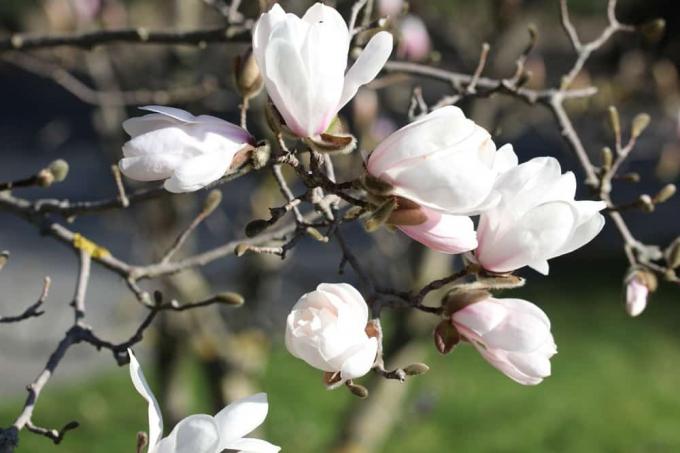
Table of contents
- Short profile
- Happen
- Location
- frost hardiness
- Plant
- Pour
- Fertilize
- Substrate for potted plants
- multiply
- cuttings
- seed
- Cut
- hibernate
- outdoor plants
- tall stems in the open air
- pot plants
- diseases and pests
- Conclusion
The evergreen magnolia is still a rarity in this country. The tree with the large white flowers is rarely found. This magnolia is something very special because it keeps its foliage even in winter. But some gardeners worry about the cold season, because the Magnolia grandiflora is known to be sensitive to cold temperatures. For this reason, it is not recommended to plant a large-flowered magnolia outdoors in particularly cold areas. In the meantime, however, there are also a number of varieties that are no longer bothered by cold temperatures.
Short profile
- botanical name: Magnolia grandiflora
- other names: Large-flowered magnolia
- belongs to the magnolia genus
- Height of growth: up to about 25 meters
- grows very slowly
- Flowers: white, tulip-shaped, up to 20 cm in diameter
- Flowering time: from May, isolated flowers until July
- Foliage: dark green, leathery, glossy
- evergreen
Happen
The evergreen magnolia is a very special plant species from the magnolia genus (Magnolia), because it not only keeps its leaves all year round, it also produces particularly large flowers. The evergreen tree, which can reach a height of more than 25 m when old, originally comes from the south-east of North America. There the tree is mainly found in coastal lowlands along the Gulf of Mexico in warm-temperate to subtropical climates with relatively high rainfall. The Magnolia grandiflora is considered a characteristic plant of the southern states and is also affectionately called "Southern Magnolia".
Location
The evergreen magnolia prefers a sunny to semi-shady location, which offers it protection, especially in the winter months. In wine-growing regions, it can be planted practically anywhere in the garden, as long as the soil and light conditions are right. In somewhat cooler locations, it feels more comfortable in a sheltered spot.
- Light conditions: sunny to light penumbra
- Soil: humic with good water storage capacity, rich in nutrients
- pH value: preferably in the slightly acidic range
- sheltered from strong winds
- Best suited as a solitary plant because of its height.
Tip:
Flowering dogwoods are suitable for the undergrowth of the large-flowered magnolia (Cornus florida), euonymus (Euonymus americanus) and the Virginia wax tree (Myrica cerifera) particularly good.
frost hardiness
To claim that the evergreen magnolia is very sensitive to frost is simply wrong. But the fact is that there are big differences from variety to variety. Young magnolias in particular are very sensitive to cold and icy winds. With increasing age, when the tree or shrub is well established, the winter hardiness improves a little, but it is far from being comparable to the frost resistance of native trees. The following varieties should therefore only be planted outdoors in very warm areas, such as wine-growing regions. Alternatively, of course, a container planting is possible.
- 'Little Gem': early flowering, compact growth habit, sensitive to frost
- 'Galissonière: comes from France and is considered the most common variety, not particularly frost hardy, but very heat tolerant
- 'Goliath': loosely upright growth up to 8 m, forms a closed, rounded crown, flowers at a young age
Fortunately, there are also breeds that generally tolerate frost better than others. These varieties usually come from North America. These include:
- 'Bracken's Brown Beauty': one of the most frost hardy species ever (to -25 degrees), slightly smaller leaves and flowers, the crown is slightly pyramidal in shape
- 'Edith Bogue': smaller growing species with light green underside of leaves, very hardy
- 'Exmouth': very old variety (1737), slender crown, light foliage, tolerates permanent frost
- 'Victoria': compact, dense, slightly smaller habit, frost hardy to -25 degrees, comes from Canada
Tip:
While some of the frost-sensitive magnolias survive in harsh environments, the trees are declining some years to develop a badly growing crown and only a few flowers to produce.
Plant
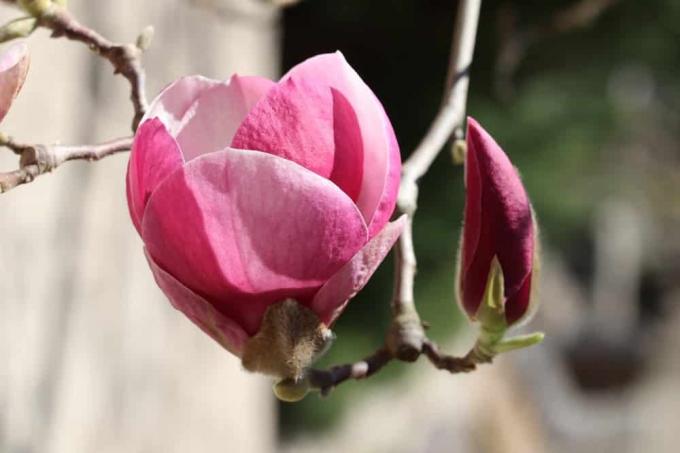
The ideal time for planting the large-flowered magnolia is in spring. Since the tree can grow very large, it should be planted at a suitable distance from buildings and property lines. Larger plants (or already trees) can also be used in mild regions in autumn. In this case, a thick layer of mulch should protect the plant from freezing through the root ball.
- Time: spring
- Planting hole: at least twice the ball size
- Enrich soil with humus
- work in grit or coarse sand if necessary (if there is a risk of waterlogging)
Pour
Since the evergreen magnolia in its homeland, the southern states of the USA, prefers river valleys or in occurs near swamps, it also needs soil in the garden that stores moisture well can. The tree does not tolerate permanent waterlogging, but it tolerates short-term flooding. The soil should ideally be consistently moist. Regular watering is therefore necessary in phases with little rain, especially in midsummer. Like other evergreen trees, the grandiflora evaporates water through its leaves in winter. Therefore, it must also be sufficiently supplied with moisture in the cold season. The Magnolia grandiflora responds to drought by shedding its leaves.
Fertilize
This type of magnolia prefers heavy, nutrient-rich soil and must therefore be supplied with fertilizer when necessary. A nutrient deficiency is clearly shown by the fact that the large-flowered magnolia suddenly loses more leaves, although it is sufficiently watered. Potted plants are watered with a high-quality liquid fertilizer for potted plants every two weeks during the growing season. For specimens planted out, it is advisable to fertilize with compost three times, in March, May and June. Alternatively, a good organic-mineral combination fertilizer for flowering shrubs can also be used.
Substrate for potted plants
One thing is particularly important for planting the Magnolia grandiflora in pots: very high-quality soil. However, it is advisable not to cultivate the evergreen magnolia in a planter in the long term, because after 10 to 15 years at the latest, the tree (especially its roots) is simply too big for the Bucket. The trees are only repotted every three to four years in spring when the root ball is well established.
- coarse-grained components (such as expanded clay, lava granules, chippings)
- ensure structural stability and drain excess water well
- moderate proportion of clay
- high humus content
multiply
Magnolias can be propagated by seeds, cuttings, layering or moss. The easiest way of propagation for inexperienced hobby gardeners is to grow from seeds or cuttings.
cuttings
Timing for cutting cuttings differs for evergreen magnolias from deciduous magnolia species. The cuttings are taken from a healthy, strong shoot in late summer or early fall.
- Cut the half-woody shoot tip
- Length: about 10 to 15 cm
- remove the lower pair of leaves
- Slightly scrape off the bark in the lower area
- stick in moist substrate
- Substrate: soil-sand mixture, potting soil or cactus soil
- set up frost-free and bright
- Keep soil slightly moist
- Plant outdoors (or in containers) next spring
seed
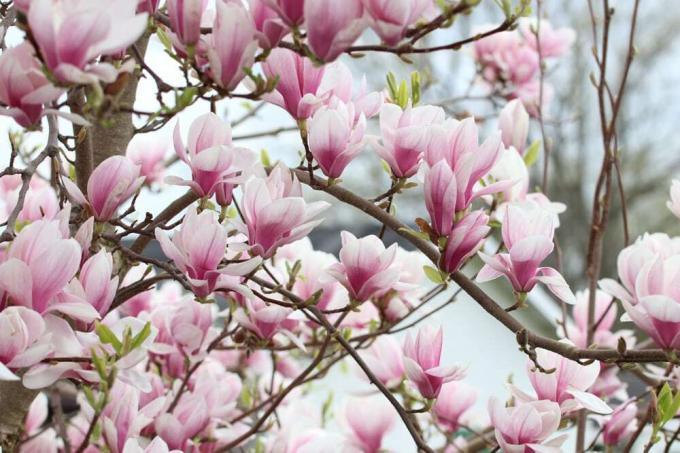
After flowering, the large-flowered magnolia forms inconspicuous, hairy pods in which the reddish-brown seeds ripen. These can be removed for propagation. However, growing from the seeds of the magnolia is a bit time-consuming. First, the seeds must be freed from the orange seed coat, as this has a germ-inhibiting effect. For this purpose, the seeds can be rubbed several times with water and sharp sand, for example. A cold period is also necessary before germination.
- put cleaned seeds in a bag with damp sand
- Store in the vegetable drawer of the refrigerator for several weeks
- from about the fourth week the seeds slowly begin to germinate
- Carefully remove the seedlings and place them in the substrate
- leave any remaining seeds in the bag and place back in the fridge
- Substrate: cactus soil, potting soil or peat moss
- Keep soil slightly moist
- Location: partially shaded (not dark)
- no direct sun
- Temperature: 15-20 degrees
- Breeding pot: rather deep than wide
- the seedling initially forms a taproot
- later a heart-shaped root system
Tip:
Large-flowered magnolia seedlings have the ability to grow under a nearly closed canopy in the shade. Therefore, they can also be sown in the shade of the mother plant without any problems.
Cut
Anyone who gets an evergreen magnolia in the garden should plan a lot of space for the noble wood. Although the tree grows very slowly, in old age it can reach a height of more than twenty meters. The crown is also quite expansive, with the branches of the tree usually only branching out a little. A Magnolia grandiflora does not necessarily have to be cut. It is sufficient to thin them out regularly and remove dead shoots. All large-flowered magnolias form their flower bases in the previous year and sprout from the old wood after winter. If you don't want to miss out on flowering next spring, you should take this into account when cutting.
- When: late winter
- alternatively (without loss of flowers): after flowering
- choose a rain-free, slightly cloudy day for cutting
- remove all dead and diseased branches
- Cut off crossing or inward-growing branches
- if the crown is to grow denser, the branches are shortened to about 2/3
hibernate
Large-flowered magnolias cultivated in wine-growing areas do not require special protection in winter. In all other regions, magnolia trees should be protected as best as possible from the icy weather. If you plant your evergreen magnolia outdoors, you should choose one of the more frost-hardy varieties to prevent frostbite. If such a specimen should ever freeze back, it is able to recover and sprout again from strong trunks and branches.
outdoor plants
As a rule, it is sufficient to cover the sensitive root area of the Magnolia grandiflora with a thick layer of bark mulch, brushwood or leaves. This is necessary because the magnolia only develops very shallow roots, which freeze completely in cold temperatures. Young trees can also be covered with fleece or a jute sack if they are exposed to strong sunlight at sub-zero temperatures. In this case, the plant evaporates water through the leaves, but cannot absorb new water from the soil. This is how dehydration occurs. As protection, the sack is simply slipped over the crown of the plant and carefully tied together at the bottom. However, it must not remain on the plant longer than absolutely necessary.
Tip:
The crown must never be covered with an airtight film. The air cannot circulate and the moisture builds up. Mold growth can usually be seen on the plant after a short time.
tall stems in the open air
All plants that are cultivated as standard trees need special winter protection outdoors.
- Wrap trunk with fleece
- Protect the crown with a jute sack in strong sunlight
- Pile up the root area in layers
- bottom layer: bark mulch
- middle layer: foliage
- lower layer: straw or brushwood
pot plants

Evergreen magnolias in pots should be brought to a bright and cool, but frost-free area over the cold season. Since the plants keep their foliage, it must not be too dark there. In principle, the warmer the location, the brighter it is. During this time, don't forget to water the Magnolia grandiflora regularly (albeit more sparingly than in summer). There is no fertilizer at all between August and March. Suitable for wintering are:
- frost-free greenhouses
- cool conservatories
- a garage with a window
- a cool, bright basement room
diseases and pests
Basically, the evergreen magnolia is rarely attacked by pests or diseases. Nevertheless, in individual cases an infestation with pests or pathogens can occur. The most common problems are known for potted plants that are overwintered too warm, too dark or too dry:
- mildew
- white bow tie
- scale insects
Tip:
As a rule, diseased magnolias recover quite quickly and only in the rarest of cases do they suffer serious damage from the infestation.
Conclusion
Evergreen magnolias are a very special addition to the garden. However, if you do not live in areas with mild winters (wine-growing areas), you must make sure you choose the right variety when planting outdoors, because not all trees and shrubs are frost-resistant. Sensitive varieties should therefore be planted in a bucket and overwintered in a cold house. If you want to be on the safe side when planting outdoors, it is best to buy the most cold-resistant varieties: Magnolia grandiflora 'Bracken's Brown Beauty' or 'Victoria'.
 garden editorial
garden editorial I write about everything that interests me in my garden.
Learn more about shrubs
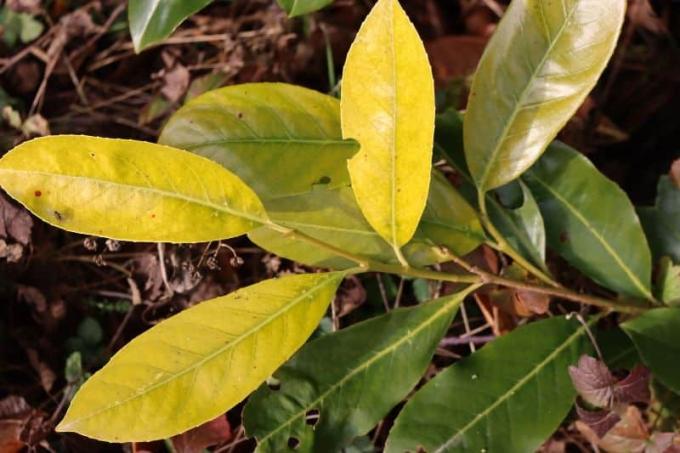
Cherry laurel has yellow / brown leaves: what to do?
Cherry laurel is one of the hardy garden plants in the garden. Nevertheless, it can happen that the leaves of the cherry laurel turn yellow or brown. The causes are manifold. Since some can kill the cherry laurel, you should investigate.

12 native evergreen shrubs & woody plants
Dreary, bare trees and bushes in winter? It doesn't have to be. Even in the European climatic conditions, native, evergreen trees thrive splendidly. The variety of species even enables the gardener to adapt his privacy hedge exactly to his garden design. This guide presents the most beautiful native and evergreen shrubs and woody plants.

Curb Vinegar | Does bucket or root barrier help?
Vinegar trees like to spread in the garden and sometimes even drive other plants away. However, this can be avoided by curbing the growth of the trees. You can find out which methods are best suited for this here!

Rhododendron has dried up: how to save it | Rododendron
Even if the rhododendron is withered and no longer sprout, it does not have to be dead. The plant can look completely dried up above ground, but there is often still life in the roots. It is therefore worth taking appropriate measures to save the flowering shrub.

Winter jasmine, Jasminum nudiflorum | Care, propagation & pruning
The winter jasmine is a relatively frugal and robust plant that can cope with many different site conditions. The plant enchants with bright yellow flowers in winter and tolerates deep sub-zero temperatures very well. It should be pruned regularly and is easy to propagate.
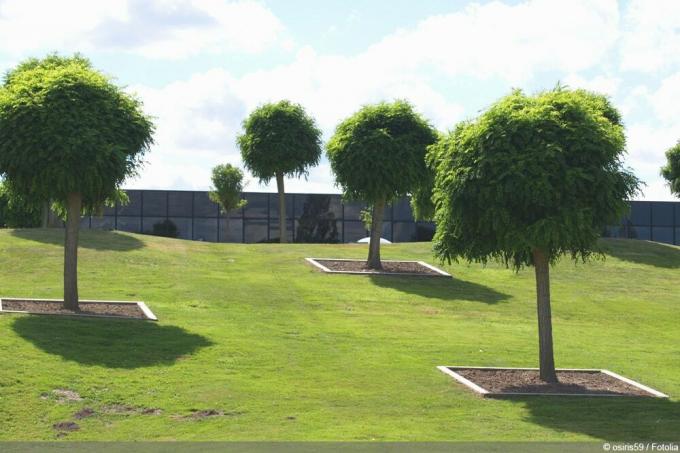
Ball Tree: Care from A – Z | These 9 varieties are suitable for ball trees
Ball trees adorn many a garden, front yard and entrance area. They require little space. Their trunk thickens with age, but its height remains the same. The spherical crown is easy to trim. Nevertheless, they offer everything that makes a tree.



